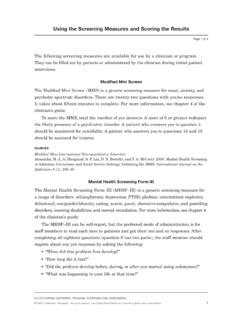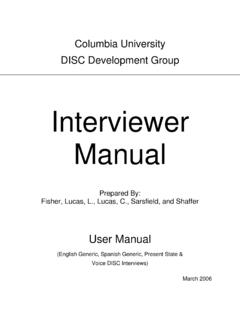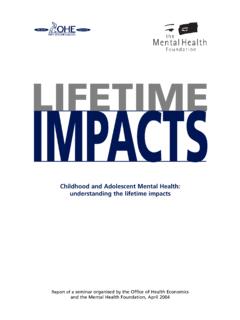Transcription of Using the Screening Measures and Scoring the Results
1 1 2008 by Hazelden Foundation. All rights reserved. Duplicating this material for personal or group use is DISORDERS PROGRAM: Screening AND ASSESSMENTU sing the Screening Measures and Scoring the ResultsPage 1 of 4 The following Screening Measures are available for use by a clinician or can be filled out by patients or administered by the clinician during initial Mini ScreenThe Modified Mini Screen (MMS) is a generic Screening measure for mood, anxiety, andpsychotic spectrum disorders. There are twenty-two questions with yes/no takes about fifteen minutes to complete. For more information, see chapter 4 of theclinician s score the MMS, total the number of yes answers. A score of 6 or greater indicatesthe likely presence of a psychiatric disorder.
2 A patient who answers yes to question 4should be monitored for suicidality. A patient who answers yes to questions 14 and 15should be assessed for Mini International Neuropsychiatric InterviewAlexander, M. J., G. Haugland, S. P. Lin, D. , and F. Health Screeningin Addiction, Corrections and Social Service Settings: Validating the Journal on theAddictions 6 (1): 105 Health Screening Form IIIThe Mental Health Screening Form III (MHSF III) is a generic Screening measure for a range of disorders: schizophrenia; depression ; PTSD; phobias; intermittent explosive,delusional, sex/gender/identity, eating, manic, panic, obsessive-compulsive, and gamblingdisorders; learning disabilities; and mental retardation. For more information, see chapter 4of the clinician s MHSF III can be self-report, but the preferred mode of administration is forstaff members to read each item to patients and get their yes and no responses.
3 Aftercompleting all eighteen questions (question 6 has two parts), the staff member shouldinquire about any yes response by asking the following: When did this problem first develop? How long did it last? Did the problem develop before, during, or after you started Using substances? What was happening in your life at that time? Page 2 of 4 Using the Screening Measures and Scoring the Results2 2008 by Hazelden Foundation. All rights reserved. Duplicating this material for personal or group use is DISORDERS PROGRAM: Screening AND ASSESSMENTThe total number of yes responses does not necessarily indicate any specific skilled clinician must evaluate each response , J. F. X., and J. J. McGinley. 2001. A Screening Form for Identifying Mental Health Problems in Alcohol/Other Drug Dependent Treatment Quarterly19 (4): 33 Adapted to Include Drugs (CAGE-AID)The CAGE-AID is a sensitive screen for alcohol and drug problems.
4 CAGE is anacronym forC- Ever try to Cut backon your drinking or drug use?A- Ever been Annoyedby anyone about your drinking or drug use?G- Ever felt Guiltyor ashamed about your drinking or drug use?E- Ever had an Eye-opener or used alcohol or drugs in the morning?Answering yes to any of these questions indicates an alcohol or drug use Adapted to Include DrugsBrown, R., and L. Rounds. Screening Questionnaires for Alcohol and Drug Abuse: TwoPilot , J. A. 1984. Detecting Alcoholism: The CAGE of the American MedicalAssociation252:1905 3 of 4 Using the Screening Measures and Scoring the Results3 2008 by Hazelden Foundation. All rights reserved. Duplicating this material for personal or group use is DISORDERS PROGRAM: Screening AND ASSESSMENTS imple Screening Instrument for Alcohol and Other Drugs (SSI-AOD)The SSI-AOD consists of sixteen items and is therefore more specific than the CAGE-AID.
5 It is simple to use, reliable, and 1 and 15 are not scored. Answering yes to four or more questions indicatesan alcohol or drug use for Substance Abuse Treatment. 1994. Simple Screening instruments for outreach for alcohol and other drug abuse and infectious Improvement Protocol (TIP) Series Publication No. (SMA) , MD: Substance Abuse and Mental Health for epidemiological studies depression scale (CES-D scale ) The Center for epidemiological studies depression scale (CES-D scale ) was developed byL. S. Radloff and published in 1977. It has been widely used in medication, psychosocialtreatment, and clinical setting prevalence studies . The CES-D scale has twenty itemsabout depressive symptoms. Items are rated on a 4-point scale as to how many days therespondent was bothered by these symptoms over the past week.
6 A total score of 60 ispossible, though scores of 16 or greater (mild to moderate depression ) and 21 or greater(major depression ) are considered clinically , L. S. 1977. The CES-D scale : A Self Report depression scale for Research in the Psychological Measurement1:385 Events Checklist and PTSD Checklist (PCL) The Life Events Checklistis part of the Screening measure used with the Clinician-Administered PTSD scale (CAPS), a structured clinical interview to determine DSM-IVdiagnosis of PTSD and symptom severity published by Western Psychological Life Events Checklist assesses a respondent s experience of seventeen possiblenegative life events. These life events often qualify as DSM-IV PTSD diagnosis Criterion Aevents. The respondent will indicate whether or not he or she experienced one or more ofthese events, and the clinician will review this list post- Screening .
7 Item 17 ( Any othervery stressful event or experience ) may not qualify as a Criterion A :Criterion A for PTSD (from the DSM-IV,pages 427 428):The person has been exposed to a traumatic event in which both of the follow-ing were present: (1) The person experienced, witnessed, or was confronted withan event or events that involved actual or threatened death or serious injury, orPage 4 of 4 Using the Screening Measures and Scoring the Results4 2008 by Hazelden Foundation. All rights reserved. Duplicating this material for personal or group use is DISORDERS PROGRAM: Screening AND ASSESSMENT threat to the physical integrity of self or others; (2) the person s responseinvolved intense fear, helplessness, or , D. D., F. W. Weathers, L.
8 M. Nagy, D. G. Kaloupek, D. S. Charney, and T. M. Keane. 1996. TheDevelopment of a Clinician-Administered PTSD of Traumatic Stress8:75 PTSD Checklist (PCL)is a seventeen-item instrument that respondents rate usinga 5-point scale from 1 (not at all) to 5 (extremely), pertaining to how bothered they areby symptoms related to the traumatic event(s) listed on the Life Events items are rated as the respondent experiences them over the past month. Theseitems tap into the DSM-IVPTSD B (re-experiencing), C (hyper-arousal) and D (avoidance)criteria. Scores of 44 or more, in conjunction with at least one qualifying Criterion Aevent on the Life Events Checklist, are associated with a diagnosis of PTSD. Higherscores are associated with increased symptom , E.
9 B., J. Jones-Alexander, T. C. Buckley, and C. A. Forneris. 1996. Psychometric Properties ofthe PTSD Checklist (PCL).Behavior Research and Therapy34:669 Social Interaction Anxiety scale (SIAS) was developed and published by Mattickand Clarke in 1998 and has been used to assess prevalence, severity, and treatment out-comes of social phobia and social anxiety disorders. The SIAS is a twenty-item measureon which respondents rate their experiences in social situations associated with socialanxiety and social phobia DSM-IVcriteria. Experiences are rated on a 5-point scalefrom 0 (not at all characteristic of me) to 4 (extremely characteristic of me). Experiencesare rated on a global period of what is typical. A total score of 60 is possible with cutoffsof 34 or more indicative of social phobia (specific situations of irrational social fears withavoidance and impairment) and 43 or more indicative of social anxiety (generalizedirrational fears across numerous social situations with avoidance and impairment).
10 Notethat on items 5, 9, and 11 Scoring is reversed (a 0 = 4, a 1 = 3) to assess for , R., and C. Clarke. 1998. Development and Validation of Measure of Social Phobia Scrutiny Fearand Social Interaction Research and Therapy36:455 70.









